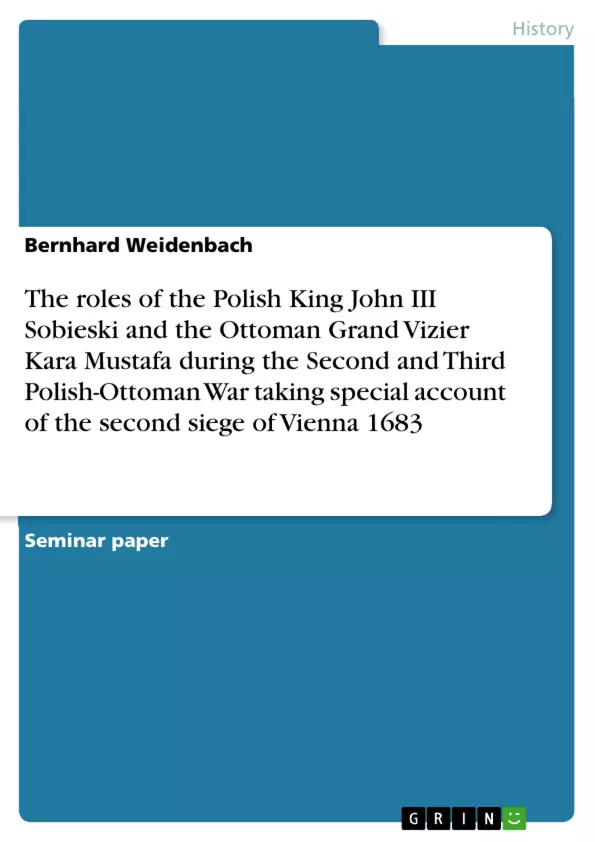In the conflict around the (second) Siege and Battle of Vienna, two antagonist leaders stuck out (among others) and are stressed out within the paper. On the one hand this is the Polish King John III Sobieski, who rushed to Vienna with a ‘multinational’ European army to relief the city and on the other hand this is the Ottoman Grand Vizier Kara Mustafa, who for his rushed to Vienna before – with an army that was possibly not less ‘multinational’ than the Sobieski’s ones. The historic relevance of these both figures and their opposing conduct, perception and legacy is the topic of this paper.
Inhaltsverzeichnis (Table of Contents)
- Introduction, sources and state of research
- Historical background and alignment
- The antagonists: John III Sobieski and Kara Mustafa
- John III Sobieski and his reign; Inner-polish developments
- Kara Mustafa
- The Battle of Vienna 1683
- Ottoman and Habsburg preparations and the beginning Siege of Vienna
- Sobieski's relief for the sieged Vienna
- Consequences and remembrance
- In general
- John III Sobieski
- Kara Mustafa
- The siege of Vienna: A religious war?
- Conclusion
Zielsetzung und Themenschwerpunkte (Objectives and Key Themes)
This paper aims to analyze the roles of Polish King John III Sobieski and the Ottoman Grand Vizier Kara Mustafa during the Second and Third Polish-Ottoman Wars, with a particular focus on the second siege of Vienna in 1683. It aims to understand the historical relevance of these two figures and their opposing conduct, perception, and legacy.
- The historical context of the Polish-Ottoman Wars leading up to the Siege of Vienna
- The lives and rise to power of John III Sobieski and Kara Mustafa
- The military preparations and events of the Siege of Vienna
- The consequences and remembrance of the Siege of Vienna for both John III Sobieski and Kara Mustafa
- The religious dimension of the Siege of Vienna
Zusammenfassung der Kapitel (Chapter Summaries)
- The introduction establishes the historical context and outlines the paper's focus on the roles of John III Sobieski and Kara Mustafa in the Siege of Vienna. It also introduces the sources and state of research on this topic.
- The second chapter provides a historical background of the Polish-Ottoman Wars, leading up to the events that triggered the Siege of Vienna.
- The third chapter delves into the lives of John III Sobieski and Kara Mustafa, exploring their paths to power and their respective roles in the conflict.
- The fourth chapter details the military preparations and events leading up to the Siege of Vienna, including the Ottoman and Habsburg preparations and Sobieski's relief effort for the besieged city.
- The fifth chapter examines the consequences and remembrance of the Siege of Vienna, focusing on the impact of the failed siege on both John III Sobieski and Kara Mustafa. It also explores their legacies and the different ways they are remembered.
Schlüsselwörter (Keywords)
Key terms and concepts of this work include the Polish-Ottoman Wars, the Second and Third Polish-Ottoman Wars, the Siege of Vienna, John III Sobieski, Kara Mustafa, Ottoman Empire, Habsburg Empire, religious warfare, military history, European history, and legacy.
- Quote paper
- Bernhard Weidenbach (Author), 2014, The roles of the Polish King John III Sobieski and the Ottoman Grand Vizier Kara Mustafa during the Second and Third Polish-Ottoman War taking special account of the second siege of Vienna 1683, Munich, GRIN Verlag, https://www.grin.com/document/900927



